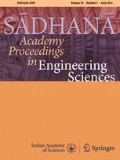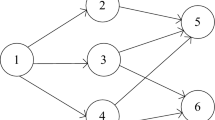Abstract
This study aims to produce a novel optimization algorithm, called the Cuckoo Search Algorithm (CS), for solving the genome sequence assembly problem. Assembly of genome sequence is a technique that attempts to rebuild the target sequence from the collection of fragments. This study is the first application of the CS for DNA sequence assembly problem in the literature. The algorithm is based on the levy flight behaviour and brood parasitic behaviour. The CS algorithm is employed to maximize the overlap score by reconstructing the original DNA sequence. Experimental results show the ability of the CS to find better optimal genome assembly. To check the efficiency of the proposed technique the results of the CS is compared with one of the well known evolutionary algorithms namely, particle swarm optimization (PSO) and its variants.








Similar content being viewed by others
References
Burks C 1994 DNA sequence assembly. Engineering in Medicine and Biology Magazine. IEEE, 13 771–773
Chandrasekaran K and Simon S P 2012 Multi-objective scheduling problem: Hybrid approach using fuzzy assisted cuckoo search algorithm. Swarm and Evolutionary compution, 5 1–16
Chen T and Skiena S 1998 Tree-based data structures for sequence assembly. Combinatorial Pattern Matching 206–223
Elloumi M and Kaabi S 1999 Exact and approximation algorithms for the DNA sequence assembly problem. SCI in Biology and Medicine 8
Engle M L and Burks C 1993 Artificially generated data sets for testing dna sequence assembly algorithms. Genomics, 16 (1) 286–288
Enrique Alba and Gabriel Luque 2008 A Hybrid Genetic Algorithm for the DNA Fragment Assembly Problem. Recent advances in Evolutionary Computation for combinatorial optimization Studies in computational Intelligence, Springer, 153: 101–112
Fang S C, Wang Y and Zhong J 2005 A Genetic Algorithm Approach to Solving DNA Fragment Assembly Problem. J. Computational and Theoretical Nanoscience, 2 499–505
Green P 1997 Against a whole genome shotgun. Genome Research 7: 410–417
Huang X and Madan A 1999 CAP3: A DNA sequence assembly program. Genome Res, 9 868–877
Kikuchi S and Chakraborty G 2006 Heuristically tuned GA to solve genome fragment assembly problem. Evolutionary Computation. IEEE: 1491–1498
Kim K and Mohan C K 2003 Parallel hierarchical adaptive genetic algorithm for fragment assembly. Evolutionary Computation, CEC’03, 1 600–607
Luque G and Alba E 2005 Metaheuristics for the DNA fragment assembly problem. Int. J. Comput. Intelligence Res., 1 98–108
Meksangsouy P and Chaiyaratana N 2003 DNA fragment assembly using an ant colony system algorithm. Evolutionary Computation, 3 1756–1763
Myers E W 2000 Towards simplifying and accurately formulating fragment assembly. J. Computational Biol., 2 275–290
Nebro A J, Luque G, Luna F, and Alba E 2008 DNA Fragment assembly using a grid-based algorithm. Computers and Operations Res., 35 2776–2790
Parsons R J and Johnson M E 1995 DNA sequence assembly and genetic algorithms- new results and puzzling insights. Proceedings of the Third International Conference on Intelligent Systems for Molecular Biology (ISMB-95), 277–284
Parsons R J, Forrest S, and Burks C 1995 Genetic algorithms, operators, and DNA fragment assembly. Machine Learning, 21 11–33
Pevzner P A 2000 Computational Molecular Biology: An Algorithmic Approach. Cambridge, MA: MIT Press1
Ravi, Vikas, and Sanjay 2011 DNA Sequence Assembly using Particle Swarm Optimization. Int. J. Comput. Appl., 28(10) 33–38
Setubal J and Meidanis J 1997 Introduction to Computational Molecular Biology. Brazil: University of Campinas, ch. 4 – Fragment Assembly of DNA, 105–139
Sutton G G, White O, Adams M D, and Kerlavage A R 1995 TIGR Assembler: A new tool for assembling large shotgun sequencing projects. Genome Science and Tech, 1 9–19
Yang X -S and Deb S 2009 Cuckoo search via Lévy flights. In Proc. of World Congress on Nature & Biologically Inspired Computing, (NaBIC 2009), IEEE Publications, USA, pp. 210–214
Yang X -S and Deb S 2010 Engineering optimization by Cuckoo search. Int. J. Mathematical Modeling and Numerical Optimization, 1 330–343
Zhao Y et al 2008 An improved ant colony algorithm for DNA sequence alignment. Int. Symp. Information Sci. and Eng. 683–688
Zuwairie Ibrahim and Tri Basuki Kurniawan 2009 Implementation of an ant colony system for DNA sequence optimization. J. Artif Life Robotics 293–296
Acknowledgements
We thank the Coimbatore Institute of Technology, Coimbatore for providing us necessary facilities and support.We are thankful to Dr. Raja CMugasimangalam, Genome Informatics team and Microarray Design Team at Genotypic Technology Private Limited, Bangalore, for the helpful discussions on genome fragment assembly.
Author information
Authors and Affiliations
Corresponding author
Rights and permissions
About this article
Cite this article
INDUMATHY, R., UMA MAHESWARI, S. & SUBASHINI, G. Nature-inspired novel Cuckoo Search Algorithm for genome sequence assembly. Sadhana 40, 1–14 (2015). https://doi.org/10.1007/s12046-014-0300-3
Published:
Issue Date:
DOI: https://doi.org/10.1007/s12046-014-0300-3




